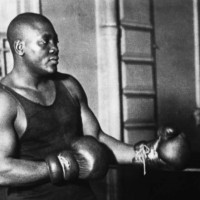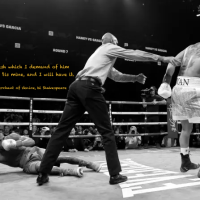 In a time of apathy toward the heavyweight of the modern era, and those geriatric contenders still squatting from the era preceding it, it is easier than ever to wallow in sepia toned nostalgia. To consider the impact even the uncrowned contenders of the 1970’s, Lyle or Quarry would have had among the flawed behemoths of the 21st century is to conjure the image of a fox in the hen house. Reach further, back as far as the halcyon days of Jack Dempsey and one would fear for the lives of his pampered successors.
In a time of apathy toward the heavyweight of the modern era, and those geriatric contenders still squatting from the era preceding it, it is easier than ever to wallow in sepia toned nostalgia. To consider the impact even the uncrowned contenders of the 1970’s, Lyle or Quarry would have had among the flawed behemoths of the 21st century is to conjure the image of a fox in the hen house. Reach further, back as far as the halcyon days of Jack Dempsey and one would fear for the lives of his pampered successors.
The Dempsey legend has grown through the annals of time. Every generation further sanitising boxing to the point that Dempsey’s merciless thuggery becomes irrelevant yet revered in equal measure. A fact underlined by the famous long count enjoyed by nemesis Gene Tunney, so programmed to destroy was Dempsey that he forgot the then newly invoked rule that a fighter must retreat to a neutral corner in the event of a knock down. It is little surprise the word retreat or retire, even in the context of having just floored his opponent, caused the irrepressibly offensive Dempsey problems. Within the 14 seconds that elapsed during the ‘Long Count’ boxing took a huge step toward legitimacy in the public consciousness although Tunney’s ensuing victory simultaneously ensured the professional demise of the sport’s most famous son.
Dempsey’s place among the heavyweight greats is assured, though his exact position remains a point of debate. Observers wrestle with the restrictions his unrefined, often unpalatable style would have been subject to within current regulation and the disparity between his own 185 pound frame and the 260 pound giants he would’ve encountered seventy years on. To allow these factors to prevail over Dempsey’s power, menace and resolve would be to underestimate the late champion and over play the effectiveness of size. Size, though daunting Dempsey would concede as he witnessed Jess Willard disrobe ahead of their contest, proved little protection for the men Dempsey faced whether they be in the full glare of a 100,000 spectators or a handful of baying miners urging on a then 13 year old Dempsey, in the mismatched brawls he undertook to survive in his homeless youth.
He, and his promoter Doc Kearns, were unquestionably the architects of boxing’s revival in the 1920’s and the creators of some of the sport’s greatest events. Whatever his relevance today, Dempsey should be acknowledge as the fighter who reconnected boxing with its public and was arguably the sports greatest ever superstar. His noteriety and renown achieved long before television became a vehicle for boxing and provided oxygen to the careers and ego of sporting giants like Muhammad Ali and Oscar DeLaHoya.
Thomas Hauser, a modern day equal of any of the great writers that helped form the Dempsey legend, and to whom he refers within his piece, provides an enthralling synopsis and thoughtful perspective on the Manassa Mauler’s career in his latest article for SecondsOut.com. Drawing from recorded account and the various biographies in which Dempsey has been captured, Hauser has compiled a digestible memoriam to the phenomenon Dempsey became. His contests, the staggering attendances he drew, the financial records he broke and the brutal origins of Dempsey vicious fighting style are all beautifully documented.
I implore boxing fans to read Thomas piece, click here, if only to provide a moment or two of welcome relief from the soporific bunch presently heading up the division.









The grainy black and white is what makes boxing great, that so much of the sport remains the same. It has a timeless quality that makes it more real, a sport of greater substance than the team games ‘like football’ which have been sugar coated and bastardised to suit television.
LikeLike
I just cant relate at all to any boxing, especially heavyweight boxing prior to say 1960.
1)The grainy footage means you cant tell what the hell is going on half the time in these fights, especially pre war
2) Obviously with training and nutrition improvements over time, especially since the 80’s comparing a Rocky Marciano to Lennox Lewis is like comparing Sugar Ray Robinson to Evander Holyfield. They are that far, in terms of size, apart.
I find the whole thing an exercise in pure futility. Like making love after 12 pints or something
LikeLike
Sultan,
Picking a top five of all time heavyweight is hard on Dempsey, because Lewis would have demolished all but the elite at his best. I think we could assume, as you propose, Dempsey would have been a fearsome light-heavyweight or, alternatively, would have benefited from modern day training and nutrition expertise to gain 15-20 pounds of effective mass.
Frazier weighed just 10-15 pounds more than Dempsey, was shorter and was competitive in a golden era.
I fail to see how Dempsey couldn’t have come close to his level of achievement. Though obviously, as I suggest, the confines of modern day regulation would have suffocated his style.
LikeLike
If he fought today, Jack Dempsey would not be a heavyweight. He would be a powerful light-heavyweight. He would make an interesting fight with Roy Jones. It is possible he could gain 20 pounds, but still he is way too small to be a great heavyweight today. Lennox Lewis would have pounded Demsey senseless. If not every time, 9 out of 10.
The Sultan on Sports
http://www.tsos20.wordpress.com
LikeLike